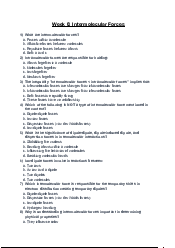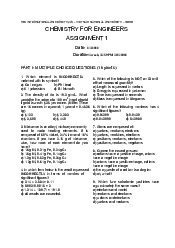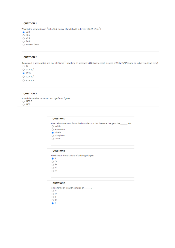










Preview text:
Q U E S T I O N 1
1. Covanlent bond is formed when electrons are ___ between atoms, whereas ionic bond
is created when there is a ___ between electrons of different atoms (Atoms try to
connect to other atoms by bond to obtain usually ___ electrons in valence shell and
become stable). (in order answer) a transfer, . shared, 8 b shared, . transfer, 8 c shared, . transfer, 6 d transfer, . shared, 6 10 points Q U E S T I O N 2
1. The geometric structure of BrF3 is: a Linear shape . b Octahedral shpae . c T-shape (Trigonal . bipyramidal shape) d Tetrahedral shape . 10 points Q U E S T I O N 3
1. A nonpolar bond will form between two __________ atoms of __________ electronegativity. a Different, . opposite b Identical, equal . c Identical, . different d Similar, . different e Different, . different 10 points Q U E S T I O N 4
1. Classify each of the following solids as ionic, metallic or covalent: KF, I2, Dry ice (Cold
CO2), Sand (Si + other compounds) (in order) a Ionic, covalent, covalent, . covalent b Ionic, covalent, ionic, . covalent c Ionic, covalent, ionic, . metallic d Ionic, covalent, covalent, . metallic 10 points Q U E S T I O N 5
1. According to VSEPR theory, if there are five electron domains in the valence shell of
an atom, they will be arranged in a(n) __________ geometry. a Bent (V-shape) . b Octahedral . c Linear . d Tetrahedral . e Trigonal . bipyramidal 10 points Q U E S T I O N 6
1. What is the general formula of molecules with trigonal bipyramidal shape? (Where
M, X represent atom(s), E is lone pairs of electron(s)) a MX . 3 b MX3E . 2 c MX2E . 2 d MX . 2E 10 points Q U E S T I O N 7
1. Write down Lewis structure of CO2 and what are lone pairs of electrons of C left?
a 3 lone pairs of electrons of . C left.
b 1 lone pairs of electrons of . C left.
c 2 lone pairs of electrons of . C left.
d 0 lone pairs of electrons of . C left. 10 points Q U E S T I O N 8
1. Which of the following statements are TRUE about ionic bonding?
a Electrostatic attraction between oppositely- . charged ions b All of the choices . c Electrons tranfered .
d Between a metal and a non-metal . 10 points Q U E S T I O N 9
1. The bond angle S-C-S in CS2 is __________. a 120o . b 180o . c 109.5 . o d 90o . 10 points Q U E S T I O N 1 0
1. The geometric structure of H2O is: a Tetrahedral shape . b Octahedral shpae . c Trigonal . bipyramidal shape d Linear shape . 10 points Q U E S T I O N 1 1
1. (READ CAREFULLY) You land on a distant planet in another universe and find that
the n = 1 level can hold a maximum of 4 electrons, the n = 2 level can hold a
maximum of 5 electrons, and the n = 3 level can hold a maximum of 3 electrons. Like
our universe, protons have charge of +1, electrons have a charge of -1, and opposite
charges attract. Also, a filled shell results in greater stability of an atom, sot the atom
tends to gain or lose electrons to give a filled shell. Predict the formula of a
compound the results from the reaction of a neutral metal atom X, which has 7
electrons, and a neutral nonmetal atom Y, which has 3 electrons: a X . 7Y3 b None of . them c X . 3Y7 d XY . 3 e X . 3Y 10 points Q U E S T I O N 1 2
1. What does Gilbert Lewis's theory of chemical bonding state?
a The most stable configuration for many elements is one that contains eight . valence electrons b All of the choices .
c Atoms bond together to fill their valence shells .
d A chemical bond is formed when an atom's electrons interact with each other . 10 points Q U E S T I O N 1 3
1. What is Octet Rule? And which elements are following Octet Rule?
a Atoms tend to gain, lose or share protons so that each atom has full outermost
. energy level which typically 8 electrons (s & d orbitals).
b Atoms tend to gain and lose electrons so that most of atoms have full
. outermost energy level which typically 8 electrons (s & p orbitals).
c Atoms tend to gain, lose or change electrons so that each atom has full
. outermost energy level which typically 8 electrons (s & d orbitals).
d Atoms tend to gain, lose, or share electrons so that each atom has full
. outermost energy level which typically 8 electrons (s & p orbitals). 10 points Q U E S T I O N 1 4
1. The type of compound that is most likely to contain a covalent bond is _________.
a One that is composed of a metal from the far left of the periodic table and a
. nonmetal from the far right of the periodic table
b Held together by the electrostatic forces between oppositely charged ions . c A solid metal .
d One that is composed of only nonmetals . 10 points Q U E S T I O N 1 5
1. The geometric structure of HCN is: a Octahedral shpae . b Trigonal . bipyramidal shape c Tetrahedral shape . d Linear shape . 10 points Q U E S T I O N 1 6
1. There are __________ paired and __________ unpaired electrons in the Lewis symbol for a phosphorus atom. a 4, . 1 b 3, . 2 c 2, . 3 d 1, . 4 10 points Q U E S T I O N 1 7
1. The difference in electronegativity (χ) between atoms is used to determine the type
of bond, thus ∆χ are 0.0 – 0.3, 0.3 – 1.7, 1.7 - 4.0, the bonds are ___, ___, and ___ respectively. a None of them . b non-polar, polar, . ionic c ionic, polar, non- . polar d polar, non-polar, . ionic 10 points Q U E S T I O N 1 8
1. Giving electronegativity of Carbon (χC) is 2.5, and Oxygen (χO) is 3.5. What is the type of bond between C - O? a Non polar covalent . bond b Polar covalent bond . c Metallic bond . d Ionic bond . 10 points Q U E S T I O N 1 9
1. What is the general formula of molecules with tetrahedral shape? (Where M, X
represent atom(s), E is lone pairs of electron(s)) a MX . 2E2 b MX . 3E c MX . 4 d All of . them 10 points Q U E S T I O N 2 0
1. Which elements that contain the majority of the electron density in the following
pairs of elements (answer in order): 1. H and O; 2. Al and N; 3. In and Sb; 4. Zn and Se; a H, Al, In, . Zn b O, N, Sb, . Se c H, N, In, . Se d O, Al, Sb, . Zn 10 points Q U E S T I O N 2 1
1. What is the general formula of molecules with linear shape? (Where M, X represent
atom(s), E is lone pairs of electron(s)) MX 2 MX 3 MX MX 4 10 points Q U E S T I O N 2 2
1. What type of bonds are formed in N2O4 and what is the name of this compound? a Covalent, dinitrogen . tetroxide b Ionic, dinitrogen oxide . c Covalent, nitrogen . tetroxide d Ionic, nitrogen oxide . 10 points Q U E S T I O N 2 3
1. The bond angle O-N-O in NO - 3 is __________. a 90o . b 120o . c 109.5 . o d 180o . 10 points Q U E S T I O N 2 4
1. What is right about bond length?
1. Assist in determining the overall size and shape of a molecule
2. Longer bonds are weaker than shorter bonds
3. Multiple bonds are longer and stronger than their single bond counterparts
4. When larger atoms are joined together, the bond becomes longer a 1, 2 . b 2, 3 . c 1, 2, 4 . d All of . them 10 points Q U E S T I O N 2 5 1. Both CO 2– 3
and ClF3 have three atoms bonded to a central atom. What is the best explanation for why CO 2- 3
has trigonal planar geometry, while ClF3 is trigonal bipyramidal? a CO 2– 3
has lone pairs on its central atom, . while ClF3 has none.
b CO 2– has a charge of -2, while ClF3 has no charge. . 3
c ClF3 has lone pairs on its central atom, . while CO 2– 3 has none. d CO 2– 3
has multiple resonance structures, . while ClF3 does not 10 points Q U E S T I O N 2 6
1. Small equal-sized of drops of oil, water and mercury lie on a waxed floor. How does
each liquid behave? (use the knowledge of cohesive and adhesive force)
a Water and mercury drops are spherical, while oil drops . spread out b All drops remain spherical .
c Oil and water drops remain spherical, while mercury drops . become flat
d Water and mercury drops spread out, while oil drops are still . spherical 10 points Q U E S T I O N 2 7
1. What are the valence electrons of Na, Al, N, P? a 1 - 2 - 6 - . 5 b 1 - 3 - 5 - . 5 c 1 - 3 - 5 - . 6 d 1 - 2 - 5 - . 6 10 points Q U E S T I O N 2 8
1. The geometric structure of SF6 is: a Tetrahedral shape . b Trigonal . bipyramidal shape c Linear shape . d Octahedral shpae . 10 points Q U E S T I O N 2 9
1. Which of the following is best to descibe “Like dissolves like”?
a Ionic salts and polar liquids dissolve better in polar liquids than in . nonpolar liquids
b Nonpolar liquids dissolve better in other nonpolar liquids than in polar . liquids c A & B are right . d None of above . 10 points Q U E S T I O N 3 0
1. The bond angle H-C-H in CH4 is __________. a 90o . b 120o . c 109.5 . o d 180o . Q U E S T I O N 1
1. Which of the following statement are FALSE about the chemical bonds? a . None of the choices
b When larger atoms are joined together, the bond becomes . longer c
. Longer bonds are weaker than shorter bonds
d Multiple bond are shorter and stronger than their single bond . counterparts 10 points Q U E S T I O N 2
1. Which of the following has the bonds correctly arranged in order of increasing polarity? a Be-F, Mg-F, N-F, . O-F b Mg-F, Be-F, N-F, . O-F c O-F, N-F, Be-F, . Mg-F d N-F, Be-F, Mg-F, . O-F e O-F, Be-F, Mg-F, . N-F 10 points Q U E S T I O N 3
1. The type of compound that is most likely to contain a covalent bond is _________.
a One that is composed of a metal from the far left of the periodic table and a
. nonmetal from the far right of the periodic table b
. One that is composed of only nonmetals c . A solid metal d
. Held together by the electrostatic forces between oppositely charged ions QUESTION 7
1. Which one of the compounds below is most likely to be ionic? a ScC . l3 b . ClO2 c GaA . s d . NO2 e . CCl4 QUESTION 12
1. VSEPR (Valence Shell Electron Pair Repulsion) theory is used to determine ___, in
which the most important factor is ___ between ___. Molecule adopts the shape that
___ the electron pair repulsions. (Answer in order)
a Relative repulsion, electron pairs, geometry, . minimizes
b Relative repulsion, geometry, electron pairs, . minimizes
c Geometry, relative repulsion, electron pairs, . minimizes
d Electron pairs, relative repulsion, geometry . minimizes QUESTION 23 1. The ion that with CO is: isoelectronic a CN . - b N2 . + c . O2- d O2 . +




